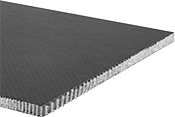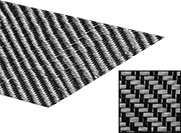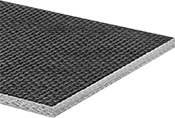About Composites
More
Composite Fiber Aramid Honeycomb Panels


- Face Color: Black
- Temperature Range: -100° to 250° F
- Yield Strength: Not Rated
- For Use Outdoors: No
With an aramid honeycomb core sandwiched between carbon fiber or fiberglass for rigidity, these panels are strong, but lightweight, and won’t conduct heat. Often used as wall panels in structural and insulating applications, they’re a lightweight alternative to solid composite and aluminum honeycomb panels.
Carbon-fiber-faced panels are stronger and more rigid than fiberglass-faced panels, so they resist deforming from bending, twisting, or buckling. They will, however, splinter from high-impact blows. These panels are lighter than fiberglass-faced panels. However, they conduct electricity, so don’t use them around electrical components.
Fiberglass-faced panels are often used around electrical components because they are good electrical insulators. They resist cracks from bumps and hits better than carbon-fiber-faced panels, but are not as strong or lightweight.
| Thickness | Thickness Tolerance | Honeycomb Cell Size | Each | |
12" × 12" | ||||
|---|---|---|---|---|
Carbon Fiber Face | ||||
| 1/8" | -0.03" to 0.03" | 0.125" | 00000000 | 0000000 |
| 1/4" | -0.03" to 0.03" | 0.125" | 00000000 | 000000 |
| 1/2" | -0.06" to 0.06" | 0.125" | 00000000 | 000000 |
Fiberglass Face | ||||
| 1/8" | -0.03" to 0.03" | 0.125" | 00000000 | 000000 |
| 1/4" | -0.03" to 0.03" | 0.125" | 00000000 | 000000 |
| 1/2" | -0.06" to 0.06" | 0.125" | 00000000 | 000000 |
Composite Fabrics

Use these resin-free fabrics to reinforce or repair existing composites as well as create new composites. Mold custom-shaped composite parts by layering your choice of fabric with an epoxy. The epoxy (sold separately) is a two-part resin that begins to harden in 15 hours and reaches full strength in 4 days. Finished composite pieces withstand temperatures up to 250° or 350° F.
Fabrics with a plain, twill, or triaxial weave have fibers that are woven in alternating directions for uniform strength and rigidity in all directions. Easier to machine than fabrics with a unidirectional weave, their woven pattern holds the fibers together to limit splintering. Twill-weave fabrics are stronger than plain-weave fabrics. They’re also more flexible, making them easier to manipulate into complex shapes. They will not, however, retain their shape as well as plain-weave fabrics.
Kevlar fabrics are a super-tough material that offers excellent wear and abrasion resistance.
Wear-Resistant Kevlar Sheets

- Color: Brown
- Max. Temperature: Not Rated
- Tensile Strength: 10,600 psi (Good)
- Impact Strength: 23.792 ft.-lbs./in. (Excellent)
- Hardness: Not Rated
- For Use Outdoors: Yes
Often used as rotor vanes in pumps and compressors, these sheets are made of Kevlar, a super-tough material that stands up to wear and abrasion.
Wear-Resistant Kevlar Tubes

- Color: Yellow
- Temperature Range: 0° F to 250° F
- Tensile Strength: Not Rated
- Impact Strength: Not Rated
- Hardness: Not Rated
- For Use Outdoors: No
These tubes are made of Kevlar, a super-tough material that stands up to wear and abrasion. Use them as sleeves to protect cords from cuts and gashes.
12" Lg. | 36" Lg. | ||||||
|---|---|---|---|---|---|---|---|
| OD | OD Tolerance | ID | ID Tolerance | Each | Each | ||
0.015" Wall Thick. (-0.012" to 0.012") | |||||||
| 0.655" | -0.012" to 0.012" | 5/8" | -0.006" to 0.006" | 0000000 | 000000 | 0000000 | 000000 |
| 0.78" | -0.012" to 0.012" | 3/4" | -0.006" to 0.006" | 0000000 | 00000 | 000000 | 00 |
| 1.53" | -0.012" to 0.012" | 1 1/2" | -0.006" to 0.006" | 0000000 | 00000 | 000000 | 00 |
| 2.03" | -0.02" to 0.02" | 2" | -0.01" to 0.01" | 0000000 | 00000 | 000000 | 00 |
Additives and Reinforcements for Composites

Mix these additives with melted plastic, epoxies, or adhesives to make parts stronger and more wear resistant without adding much weight. You can use them in batches to tackle repairs and small parts instead of machining your part from a sheet, bar, or other shape.
Kevlar
Choose these additives when your application is likely to wear down your finished part—they improve a part’s ability to stand up to corrosion, bangs, bumps, and scrapes. They’re also used to reinforce points where honeycomb cores connect to fabric. To start, mix in 1 part Kevlar to 15 parts composite.



























